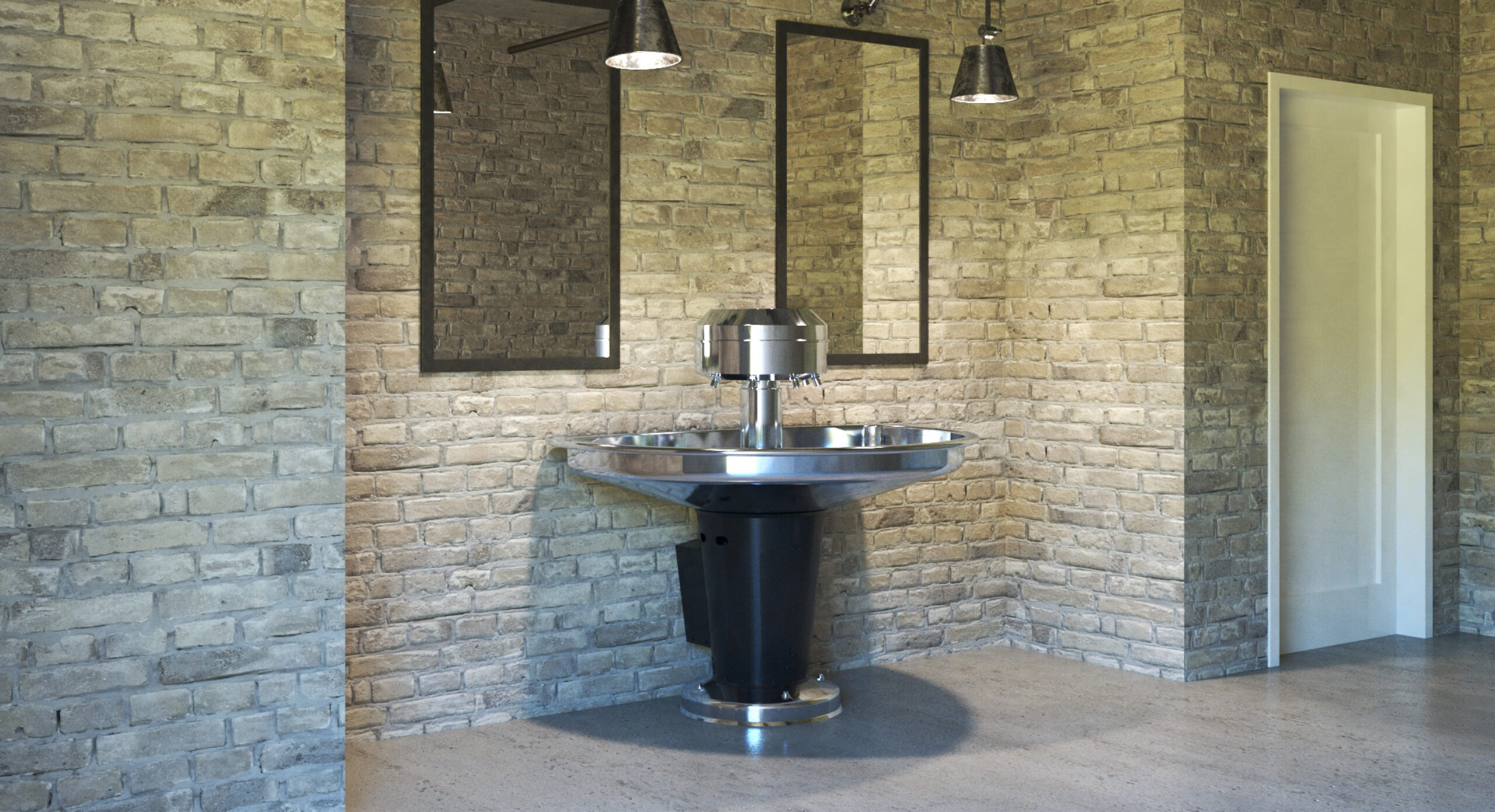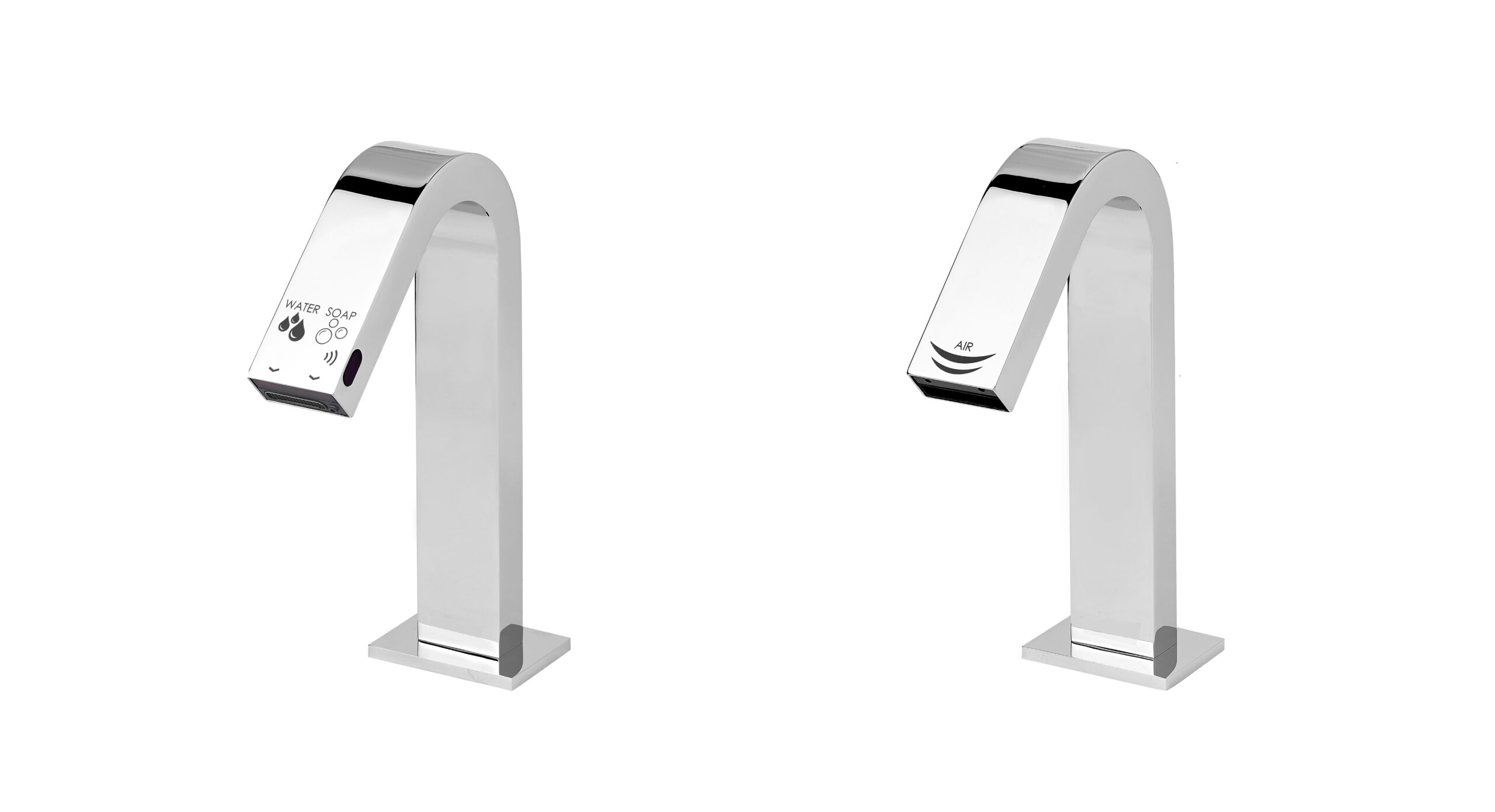Sanispray Sensor Wash Fountains
Healthcare and industrial settings tend to have hygiene standards higher than the average facility and their restroom and washroom fixtures reflect this. In the age of COVID-19, public and commercial spaces are rethinking building design and many owners are installing sensor and antimicrobial devices to keep disease at bay.
Sensor bathroom fixtures have been around since the 1980s, and they are making a comeback in many establishments to help protect staff and customers from infection. Electronic fixtures are operated by sensors that scan for objects in its detection area and activates the operation, whether it’s turning on the faucet or flushing the toilet automatically.
The benefits of electronic fixtures (water and energy conservation, antimicrobial features, ease of use, etc.) are obvious and trump the disadvantages. While sensor devices tend to be more expensive than manual units, they quickly pay for themselves.
One of the biggest complaints from users is the failure of sensors to detect objects. You have to wave your hands several times to get the faucet to work, for example. For brand-new units, this is usually caused by something covering the sensor area. Older units may simply need a new battery or a tune up.
Wash Fountains
The lavatory area can be high risk due to multiple people standing close together. Sensor faucets, dispensers and dryers can be installed along with antimicrobial solid surface sinks to make the space as safe and hygienic as possible.
In settings where space is limited, wash fountains are the best alternative. Wash fountains are freestanding systems that take up significantly less space than lavatories of equal capacity. AquaDesign wash fountains save up to 30 percent floor and wall space compared to an equal number of traditional lavatories.
They are designed for use by large groups of people, with some units supporting up to 8 users at the same time. In addition, the compact and space saving design offer an efficient traffic pattern in busy areas like factories.
AquaDesign Sanispray Sensor Washfountains
AquaDesign provides wash fountains in all sizes and with many types of activation. Our circular, semi-circular and corner washfountains fit any space requirement and has anti-vandal features for durability.
Sanispray Sensor Circular Washfountain
The circular washfountain is designed for 6 to 8 users and ideal for use in areas with heavy traffic that lack free wall space. Each of the stations have their own micro-processor, battery and sensor that controls each solenoid valve. The stainless-steel bowl measures 39-54 inches and is supported by a pedestal of 12-gauge steel that houses supply and vent pipes and supports the water distribution head.
The bowl has a parabolic shape for extra strength. This keeps water spray and splashes inside the bowl and makes the unit self-cleaning and self-draining. For ultimate safety and hygiene, the bowl can be supplied with an antimicrobial solid surface. Solid surface is made from composite material that have no crevices or seams where germs can hide. The unit can also be supplied with a hands-free soap dispenser with a preset amount of soap per shot.
Sanispray Sensor Semi-Circular Washfountain
The semi-circular Sanispray sensor washfountain is a standalone lavatory that can serve from 3 to 5 users at the same time. It is ideal for heavy traffic areas with available wall space. Each station has its own sensor to activate water flow.
The stainless-steel bowl is parabolic shaped to keep water, soap and mess inside the bowl. This makes the unit self-cleaning and self-draining. The bowl can be fitted with an antimicrobial solid surface and hands-free soap dispensers can be installed for an automated germ-free environment.
A 12-gauge steel pedestal supports the bowl and stores supply pipes, vent pipes and the water distribution head. The vandal resistant panel at the front prevents tampering of electronic components. Wall braces are not needed as the vent pipe serves as the central tie part for the rigid assembly.
Sanispray Sensor Corner Washfountain
When wall space is limited in high traffic areas, the Sanispray sensor corner washfountain is recommended as an alternative to traditional lavatory systems. It serves up to 3 users simultaneously. The ADA-compliant corner washfountain is pre-assembled and pre-plumbed for fast and easy installation (either floor mounted or wall hung).
The stainless-steel parabolic bowl is self-draining, self-cleaning and contributes to LEED requirements. The design ensures that water stays in the bowl. Spray nozzles are vandal resistant and have built-in automatic flow control to reduce water waste. The pedestal support also comes with a vandal resistant access panel to prevent damage to internal components.
To learn more, visit our Sanispray sensor wash fountains page or contact us today!
Reduce Infection Risk with Hands Free Soap and Water Faucets
Hands free soap and water faucets have been around for decades and they may become even more ubiquitous now that hygiene has become top priority. Hands free soap and water faucets and similar sensor fixtures may not completely protect people against the new coronavirus, but they can be an important line of defense in the fight against infection.
The Centers for Disease Control (CDC) and the World Health Organization (WHO) say that frequent handwashing with soap and water is the single most effective way to protect yourself against disease. Handwashing for at least 20 seconds before eating, after going to the bathroom and before preparing food removes not just visible dirt and invisible germs but also chemicals.
In the absence of soap and water, the CDC recommends the use of alcohol-based (at least 60 percent) hand sanitizer to clean your hands. In bathrooms without hands free fixtures, use a paper towel to turn off faucets, open and close doors, and flush toilets to prevent the re-introduction of germs to clean hands.
Hands Free Operation for Water and Soap
By design, hands-free fixtures avoid contact with surfaces to reduce cross contamination. Combination units like hands free soap, water and hand dryer lavatories are even better because users can wash and dry their hands in one place without touching anything. This also keeps messes from splashing on the counter and the floor.
Electronic soap and water faucets are controlled by sensors. This is usually an infrared light or ultrasonic field that detects skin and sends a signal to the faucet valve. When sensors detect the presence of an object, like a hand, they turn on the soap dispenser or the flow of water. Sensors automatically turn off the tap when the object leaves the detection area. Sensors are usually located at the base of or near the spout.
How Hands Free Soap and Water Faucets Reduce Infection Risk
COVID-19 has introduced new challenges for business owners and facility managers, who are legally responsible for the health and safety of staff and employees. Many are rethinking building and restroom design for the first time. Touch-free bathroom fixtures as well as automatic temperature monitors are becoming standard in many places.
Why use sensor faucets with soap dispensers?
Better hand hygiene. Electronic soap and water faucets allow users to keep their hands clean and prevent cross-contamination. No need to touch germ-ridden buttons or handles before or after handwashing. And because they are so easy to use, sensor faucets and soap dispensers encourage frequent handwashing.
Cleaner bathrooms. Standing water on counters and bathroom floors are breeding grounds for harmful germs. Hands free soap and water faucets prevent drips and splashes, keeping the mess in the sink and not on the floor. For public settings, this means cleaner bathrooms and less maintenance required.
Save soap and water. Electronic soap and water faucets dispense a preset amount of liquid soap per shot. This can be adjusted to suit your needs. The water also turns off automatically when hands leave the sensor area so the tap is not always running. With the faucet off, users can focus on washing their hands properly.
Improve accessibility. Most hands-free soap and water units are compliant with accessibility requirements like the American with Disabilities Act (ADA). This makes it a snap for children, the elderly, and individuals with disabilities to clean their hands.
Save money. Sensor faucets and fixtures tend to be more expensive than manual units. However, the initial investment is recouped over time because of water and energy saving features.
Better design. Electronic faucet design has vastly improved over the years. There are more options available, whether for industrial, residential, public or commercial use. Modern materials and sleek designs are perfect for offices, restaurants and shops, while robust, heavy-duty styles with antimicrobial properties are suited for healthcare and industrial settings.
AquaDesign Hands Free Faucets and Fixtures
AquaDesign manufactures electronic bathroom fixtures like the Omnia hands free soap and water faucet for an automated and germ-free experience. The deck-mounted design ensures that soap does not drip on the floor so users spend less time in the bathroom. The unit comes with a 0.4 gallon soap dispenser container that is easily removed for refilling.
AquaDesign faucets feature a modern and streamlined design that is ideal for any setting. Made with high-quality solid surface materials, the fixtures are antimicrobial, easy to maintain and last a long time. Some of our fixtures have anti-vandal features that stand up to heavy abuse—ideal for healthcare and behavioral healthcare settings.
To learn more, visit our hands free soap and water faucets page or contact us today!


